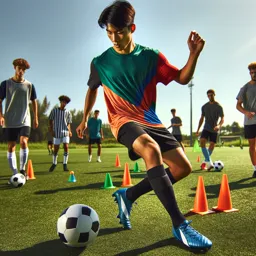Football is a physically demanding sport that requires a combination of speed, endurance, strength, and agility. Professional footballers undergo rigorous training routines to ensure they perform at their peak during matches. Whether you’re aspiring to play professionally or simply want to improve your fitness for the sport, adopting a professional footballer’s approach to training can make a big difference. In this article, we’ll explore the key fitness and conditioning components that pro footballers focus on.
1. Endurance Training
Football matches last for 90 minutes, often with little rest, meaning endurance is essential for players to maintain a high level of performance throughout the game. Pro footballers incorporate a variety of endurance-building exercises into their routine.
Key Endurance Workouts:
- Long-Distance Running: Pro footballers often run long distances to build cardiovascular endurance. Running 5-10 kilometers several times a week helps improve stamina.
- Interval Training: Interval training involves alternating between short bursts of high-intensity sprints and periods of recovery. This simulates the stop-start nature of football and boosts aerobic capacity.
- High-Intensity Interval Training (HIIT): HIIT combines intense exercise with brief rest periods, improving endurance and helping players recover faster between sprints during matches.
Pro Tip: Incorporate interval sprints into your running sessions to mimic game-like scenarios where you need to sprint, jog, and walk repeatedly.
2. Strength Training
Football requires both upper and lower body strength to shield the ball, make powerful tackles, and win aerial duels. Strength training helps players become more resilient and less prone to injury.
Key Strength Training Exercises:
- Squats and Lunges: These exercises strengthen the legs, helping with explosive power for sprints, jumps, and quick direction changes.
- Deadlifts: Deadlifts improve overall core strength and stability, which is crucial for maintaining balance and controlling the ball under pressure.
- Push-ups and Pull-ups: These bodyweight exercises develop upper body strength, helping players fend off opponents and improve their heading ability.
Pro Tip: Focus on compound movements that engage multiple muscle groups, as these are more beneficial for football-specific strength.
3. Agility and Speed Training
Agility and speed are critical in football, allowing players to outmaneuver opponents, make quick direction changes, and execute rapid sprints down the field. Professional players incorporate various agility and speed drills into their training.
Key Agility and Speed Workouts:
- Ladder Drills: Using an agility ladder helps improve foot speed, coordination, and balance. Quick foot movements are essential for dribbling and defensive maneuvers.
- Cone Drills: Setting up cones for zigzag runs helps players practice changing direction quickly while maintaining control of the ball.
- Sprint Drills: Sprints improve acceleration and top-end speed, allowing players to chase down long passes or break away from defenders.
Pro Tip: Incorporate plyometric exercises like box jumps and burpees to improve your explosive power and speed.
4. Flexibility and Mobility Training
Flexibility and mobility are often overlooked but are essential for injury prevention and overall performance. Pro footballers ensure they are limber enough to perform at their best.
Key Flexibility and Mobility Exercises:
- Dynamic Stretching: Before training or a match, pro players do dynamic stretches, such as leg swings and arm circles, to prepare their muscles for action.
- Yoga and Pilates: Many footballers use yoga and Pilates to improve flexibility, balance, and core strength, helping them stay agile and avoid injuries.
- Foam Rolling: Foam rolling helps relieve muscle tightness and increase blood flow to the muscles, which aids in recovery after intense sessions.
Pro Tip: Incorporate a cooldown routine with static stretching after every training session to maintain flexibility and reduce the risk of muscle strains.
5. Recovery and Nutrition
Recovery is just as important as training when it comes to maintaining peak performance. Pro footballers follow strict recovery protocols to ensure their bodies can handle the demands of frequent games and intense training sessions.
Key Recovery Techniques:
- Active Recovery: Light activities like swimming or cycling help players recover while still keeping their muscles engaged.
- Cold Therapy (Ice Baths): Ice baths reduce muscle inflammation and soreness, allowing for quicker recovery between matches or training.
- Sleep: Adequate rest is vital for recovery. Pro footballers aim for 7-9 hours of sleep per night to allow their muscles to repair and grow.
Pro Tip: Nutrition plays a huge role in recovery. Focus on a balanced diet rich in proteins, carbohydrates, and healthy fats to fuel your body and promote muscle recovery.
Conclusion
Training like a professional footballer requires a well-rounded approach that includes endurance, strength, agility, flexibility, and recovery. By incorporating these elements into your training routine, you can improve your overall performance on the pitch and reduce the risk of injury. Whether you’re preparing for competitive play or simply aiming to elevate your fitness, these conditioning strategies will help you train like a pro.

































